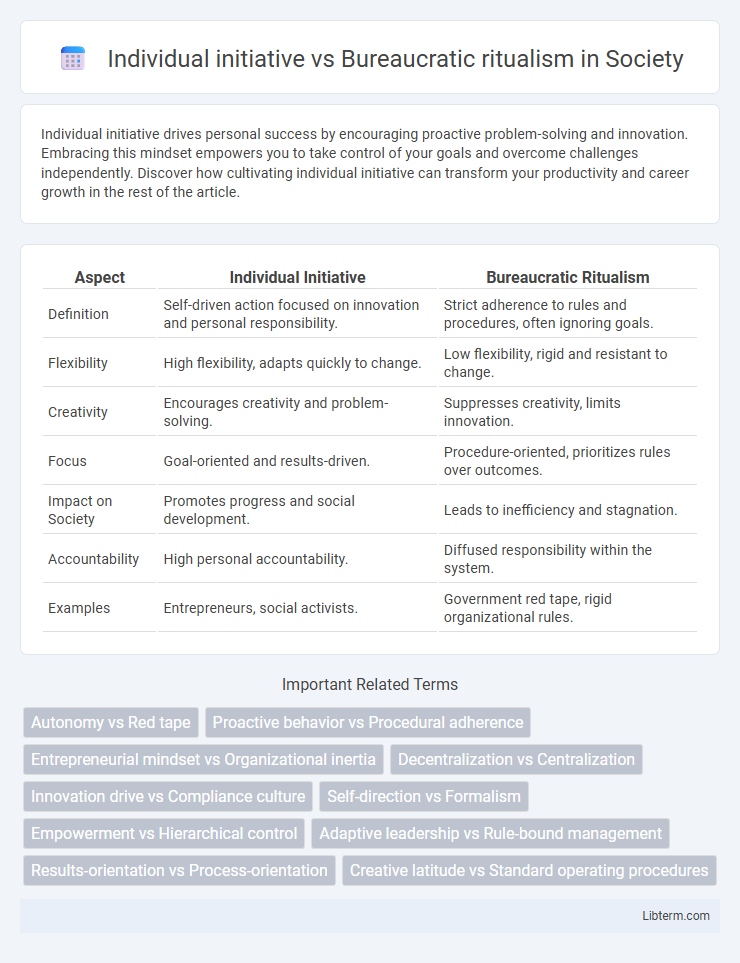Individual initiative drives personal success by encouraging proactive problem-solving and innovation. Embracing this mindset empowers you to take control of your goals and overcome challenges independently. Discover how cultivating individual initiative can transform your productivity and career growth in the rest of the article.
Table of Comparison
| Aspect | Individual Initiative | Bureaucratic Ritualism |
|---|---|---|
| Definition | Self-driven action focused on innovation and personal responsibility. | Strict adherence to rules and procedures, often ignoring goals. |
| Flexibility | High flexibility, adapts quickly to change. | Low flexibility, rigid and resistant to change. |
| Creativity | Encourages creativity and problem-solving. | Suppresses creativity, limits innovation. |
| Focus | Goal-oriented and results-driven. | Procedure-oriented, prioritizes rules over outcomes. |
| Impact on Society | Promotes progress and social development. | Leads to inefficiency and stagnation. |
| Accountability | High personal accountability. | Diffused responsibility within the system. |
| Examples | Entrepreneurs, social activists. | Government red tape, rigid organizational rules. |
Understanding Individual Initiative
Individual initiative drives innovation and problem-solving by encouraging proactive decision-making and creativity within organizations. It contrasts with bureaucratic ritualism, which rigidly adheres to established rules and procedures, often stifling flexibility and responsiveness. Understanding individual initiative highlights its crucial role in fostering adaptability and dynamic leadership in complex, evolving environments.
Defining Bureaucratic Ritualism
Bureaucratic ritualism refers to the rigid adherence to rules and procedures within an organization, often at the expense of original goals and individual creativity. It manifests when employees prioritize following established protocols over problem-solving or adapting to changing circumstances. This phenomenon reduces organizational efficiency by fostering inflexibility and discouraging individual initiative.
Historical Contexts of Both Approaches
Individual initiative thrived during periods of rapid innovation and social change, such as the Renaissance and the Industrial Revolution, enabling creative problem-solving and entrepreneurial ventures. Bureaucratic ritualism became prominent in the 20th century with the expansion of government and large corporations, emphasizing standardized procedures and hierarchical control to maintain order and efficiency. The tension between these approaches reflects shifting historical priorities between flexibility and stability in organizational and societal development.
Key Differences Between Initiative and Ritualism
Individual initiative emphasizes creativity, personal responsibility, and proactive problem-solving to achieve goals, fostering innovation and adaptability. Bureaucratic ritualism prioritizes strict adherence to rules, routines, and procedures, often resulting in rigidity and resistance to change. The key difference lies in initiative promoting dynamic action and flexibility, whereas ritualism enforces conformity and procedural compliance.
Impacts on Organizational Efficiency
Individual initiative drives innovation and adaptability within organizations by encouraging proactive problem-solving and creative decision-making. In contrast, bureaucratic ritualism often leads to rigid adherence to rules and procedures, causing delays and reduced responsiveness to change. This tension between flexibility and formalism significantly shapes organizational efficiency, where excessive ritualism can stifle productivity while fostering routine compliance.
Case Studies: Success Through Initiative
Case studies reveal that individual initiative often drives innovation and adaptability, outperforming rigid bureaucratic ritualism in dynamic environments. Examples from tech startups and agile organizations demonstrate how personal agency and creative problem-solving lead to measurable success, such as increased productivity and market responsiveness. Contrastingly, bureaucratic ritualism frequently results in inefficiencies and stagnation due to strict adherence to predefined procedures.
Case Studies: Failures Due to Ritualism
Case studies reveal how bureaucratic ritualism stifles individual initiative, leading to organizational failures such as the Challenger disaster and the 2008 financial crisis. In these instances, adherence to rigid procedures overshadowed critical risk assessment and innovative problem-solving, resulting in catastrophic outcomes. The suppression of proactive decision-making highlights the necessity of balancing standardized protocols with flexibility and creative agency.
Balancing Structure with Flexibility
Balancing structure with flexibility requires managing individual initiative without stifling innovation through bureaucratic ritualism. Organizations that promote employee autonomy and adaptable workflows can avoid rigid procedures that hinder responsiveness and creativity. Implementing clear guidelines alongside room for personal judgment fosters efficient yet dynamic operations.
Cultivating Initiative in Bureaucratic Settings
Cultivating initiative in bureaucratic settings requires balancing procedural adherence with empowering employees to make decisions and innovate within established frameworks. Encouraging a culture that values proactive problem-solving and grants discretion can reduce the stagnation caused by rigid ritualism. Implementing targeted training, clear communication channels, and performance incentives fosters individual initiative while maintaining organizational discipline.
Future Trends: Rethinking Organizational Processes
Future trends highlight a shift from bureaucratic ritualism toward individual initiative by integrating agile methodologies and decentralized decision-making to enhance organizational adaptability. Artificial intelligence and digital collaboration tools empower employees to innovate and respond swiftly, reducing reliance on rigid bureaucratic protocols. This evolution redefines organizational processes, prioritizing flexibility, creativity, and employee autonomy in achieving strategic objectives.
Individual initiative Infographic

 libterm.com
libterm.com